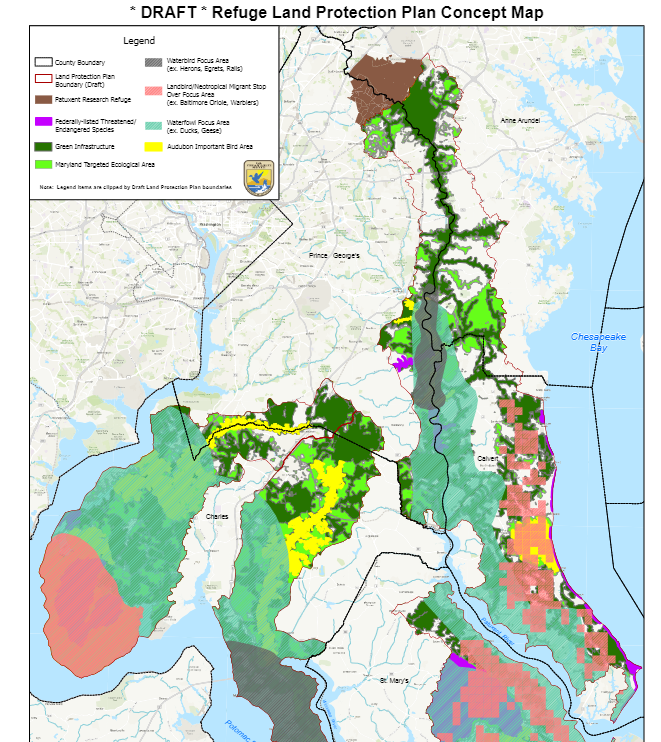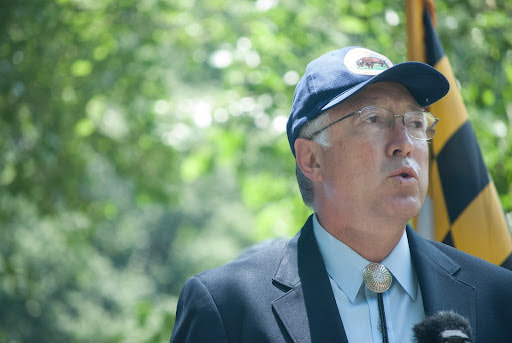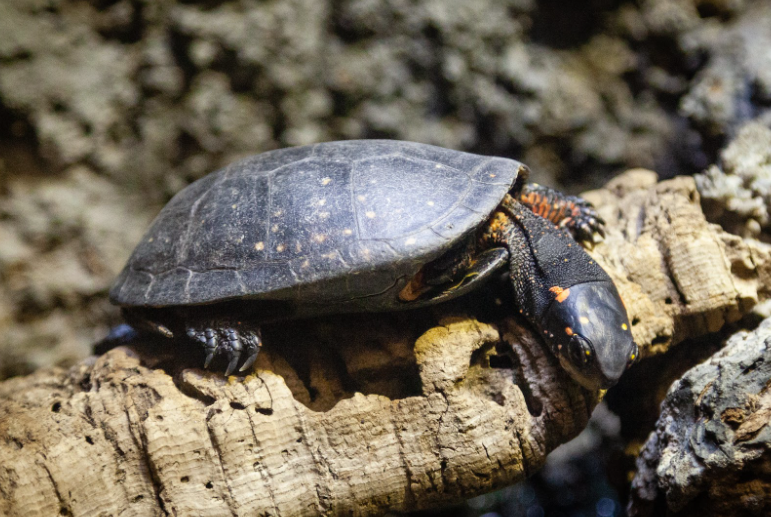Long-eared bat is a federally endangered species spotted within the proposed possible acquisition boundary of the refuge.
Guest written by: Joe McCauley
Joe McCauley, retired from the United States Fish and Wildlife Service, Joseph McCauley brings vast conservation experience, both at the policy level and in the field, as an advisor to Chesapeake Conservancy.
On March 8, 2024, the U.S. Fish and Wildlife Service (FWS) released a Draft Environmental Assessment and Land Protection Plan (EA/LPP) to establish a new national wildlife refuge in Southern Maryland. If approved by the FWS Director, the Southern Maryland Woodlands National Wildlife Refuge (Refuge) boundary would encompass over 577,000 acres, making it a true landscape-level conservation initiative in which partners are expected to play a major role. It would be the first national wildlife refuge created in the Chesapeake Bay watershed in 26 years!
A map detailing a land protection plan from the FWS

Within this refuge boundary, FWS and its partners can assist in the conservation of up to 40,000 acres through fee-title acquisitions or easements from sellers who are willing to part with the land they own. Landowners are under no obligation to sell or donate their interests in land; all conservation will be voluntary.
The release of the Draft EA/LPP for a 45-day public review and comment period marks a milestone in the 15-year pursuit to conserve the well-documented, nationally significant fish and wildlife habitats in southern Maryland. One might ask, “Why did it take so long?” and “What’s next?”
To answer the first question, we need to go back to the advent of the Obama administration and the President’s appointment of Ken Salazar to be Secretary of the Interior. In 2009, during the first year of his administration, President Obama issued Executive Order 13508 – Chesapeake Bay Protection and Restoration. Those working in the realm of natural resource conservation in the Bay watershed know well the dramatic and far-reaching effects of this Order, including the creation of the Chesapeake Conservation Partnership. Federal agencies were charged with planning and implementing actions that they could take with state and local partners from across the spectrum of natural resource conservation to increase and enhance land protection and restoration in the Bay watershed. Among the goals that emerged from the initial planning effort was one to conserve an additional 2 million acres of land by 2025, and one of the primary funding sources identified to achieve that goal was the Land and Water Conservation Fund (LWCF).

Secretary Salazar was a fervent supporter of National Wildlife Refuges. His support and love of NWRs set an early foundation for many proposed refuges, including the Southern Maryland Woodlands National Wildlife Refuge.

The spotted turtle is an FWS ‘At-Risk’ species that can be found throughout Southern Maryland. The proposed refuge would go a long way in conserving the turtle’s habitat and ecosystem.
Recognizing opportunity when it knocked and working with folks from Patuxent Research Refuge (PRR), Dan began organizing a large and diverse assemblage of stakeholders to discuss and formulate a plan to analyze the landscape in more detail and, if warranted, to propose the establishment of a new refuge. The response from partners was overwhelmingly positive, prompting Dan and Sandy Spencer and Brad Knudsen from PRR to draft a Preliminary Project Proposal (PPP), which is the first step in the FWS process to evaluate the merits of creating a new national wildlife refuge. The requirements of a PPP are several-fold, including location and size, description of the habitats, major wildlife values, threats, funding, anticipated costs and more. The PPP for the southern Maryland proposal was approved by the FWS Director in 2011. Then, the bureaucracy kicked in.
It seems Secretary Salazar’s enthusiasm for creating new refuges unleashed a pent-up demand and PPPs from around the country began flowing into headquarters. Faced with the prospect that newly created refuges could overwhelm NWRS budgets and staffing, which have always been lean, FWS leadership decided that new policy was warranted to guide the growth of the NWRS. This put on hold all the new refuge proposals that were in the pipeline, including the S. Maryland proposal.
The FWS Strategic Growth Policy (Strategic Growth Policy | U.S. Fish & Wildlife Service (fws.gov)) was published in September 2014. The policy requires that before a new refuge or major refuge boundary expansion can move into the detailed planning stage, FWS must work with partners to develop a landscape conservation design (LCD). The FWS defines a LCD as “… a partnership-driven process that assesses current and anticipated future biological and socioeconomic conditions, depicts spatially-explicit desired future conditions, and produces a suite of management strategies for achieving those conditions on a landscape scale.”
Undeterred, Dan harnessed the energy and enthusiasm of the partnership that he had been nurturing for years to refocus on creating an LCD, the results of which are encapsulated in the Draft EA/LPP that is now available for review. The LCD process, which examined and evaluated over 100 datasets of valuable environmental and ecological information, was completed in 2018. It confirmed in greater detail what preliminary evaluations suggested that a new national wildlife refuge in Southern Maryland was warranted to help conserve the threatened fish and wildlife resources that depend on habitats found there. Unfortunately, the timing was not politically advantageous, and the proposal was shelved until 2021.
In January 2021, President Biden issued Executive Order (EO) 14008 entitled “Executive Order on Tackling the Climate Crisis at Home and Abroad.” The EO directed the departments of the Interior, Agriculture, and Commerce and the Council on Environmental Quality to issue a report “recommending steps that the United States should take, working with State, local, Tribal and territorial governments, as well as agricultural and forest landowners, fishermen and other key stakeholders to achieve the goal of conserving at least 30 percent of our lands and waters by 2030.” This has become known as the “30×30” initiative, which has been adopted by the State of Maryland, Chesapeake Conservancy and many other concerned entities. The Draft EA/LPP responds to President Biden’s challenge and puts the NWRS squarely in the mix.
All interested parties have the opportunity to participate and provide comments during the open 45-day public comment period. Please submit comments and questions to: [email protected]. All comments must be received by April 22, 2024.
During the public comment period, FWS hopes to hear from as many voices as possible to ensure that the proposal is well understood and supported in the communities it is intended to serve. The opportunities for land conservation, wildlife-oriented recreation, environmental education, and enhancements to the quality of life that emanate from this proposal are boundless and limited only by the enthusiasm and dedication of those who support it. It will take time, funding, patience, persistence, volunteerism, and more for the refuge to realize its full potential. Chesapeake Conservancy is proud to be among the many partners who have contributed to this initiative over the past 15 years, and we stand ready to see it through.
For more information, please see Evaluating New Refuge Lands in Southern Maryland | U.S. Fish & Wildlife Service (fws.gov).
Image credit:
- US Fish and Wildlife Service
- Chesapeake Bay Program
- Chesapeake Bay Program
- US Fish and Wildlife Service
Lightning Update is a regular communication of the Chesapeake Conservation Partnership. Any opinions expressed are those of the authors and do not necessarily reflect positions of the Partnership or member organizations.
To share a success story, news, or important event, send your information to:
Support for the Chesapeake Conservation Partnership is provided by:
National Park Service Chesapeake
EPA Chesapeake Bay Program
USDA Forest Service
Pennsylvania Department of Conservation & Natural Resources
Virginia Outdoors Foundation
US Fish & Wildlife Service
Chesapeake Conservancy
The Chesapeake Conservation Partnership is co-convened by:




